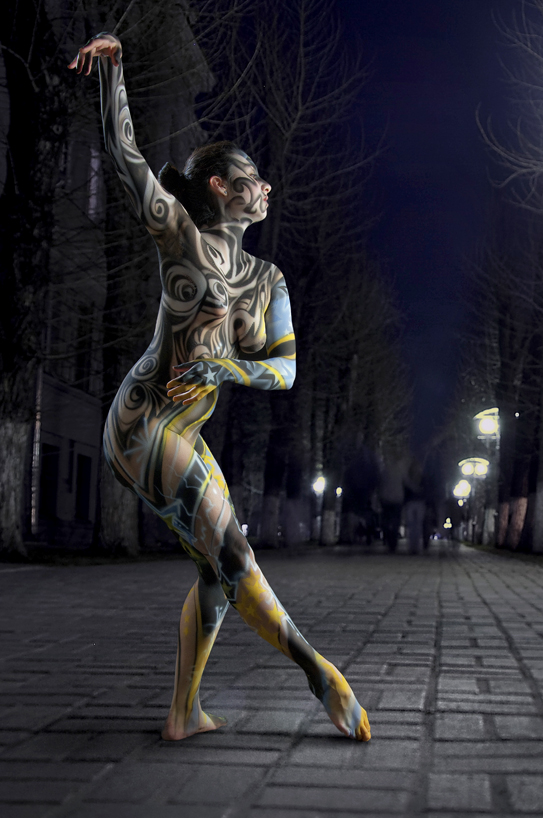Logo t-shirts, skinny jeans, and boys with shoulder length haircuts: what do these all have in common? They are all popular fashions from the seventies and eighties that became freshly rejuvenated styles in the 2000s.
Body painting, the application of paint/makeup to human skin, like many other fashions and forms of art, also experienced this reawakening. Except many people may not have realized this yet.
It can be debated that body painting is one of the oldest forms of art, often used in tribes as a form of rank or hierarchy. And over the centuries, the art-form evolved into different applications ranging from the traditional tribal, to go-go dancers, to Hollywood cinema, including such techniques as fantasy, camouflage, decoration, conceptualization, and tromp l’oeil.
In my opinion, body painting reached its undisputed highest glory in the 70s, when renowned fashion model/experimental artist, Veruschka (http://www.veruschka.net/), took her explorations to the most radical levels. She was essentially responsible for popularizing the camouflage technique, in which she would be painted, by herself and occasionally the photographer, to resemble the decaying environment, sometimes to the point where she seemed invisible.
Veruschka was also responsible for very conceptual photographic series’ where she would “remove” her painted clothing until nude, and then remove her skin to reveal the illusion of clothing underneath. Many of her techniques are still copied today, and those that knew of her then, still talk of her today, forty years later.
In the 90s, the art form was pioneered into the commercial industry by Joanne Gair (http://www.joannegair.com/). She is most notably recognized for her work with Annie Leibovitz and Demi Moore on the cover of a 1992 Vanity Fair (http://glamourphotography.co/wp-content/uploads/2011/01/Demi-Moore-Vanity-Fair-cover-1992-BodyPaint-by-Joanne-Gair.jpg) in which a fully nude Moore was painted in a tromp l’oeil styled, faux suit and tie. That image was arguably the most influential image for countless body painters today, including myself. This also proved to be the main springboard for Gair’s career. She has since continued on to do numerous episodes of America’s Top Model(and other continental versions), is the head artist for the painted bikinis seen every year, since 1999, in the Sports Illustrated, and she is regularly involved with countless magazines, fashion campaigns, and TV/Film spots. Gair is perhaps the most prolific body painter to date.
The commercial popularity of body painting resulted in endless amounts of copycat styles, which consequently began to cheapen its reputation. In the 2000s, when people thought body paint, they pictured cheetahs or faux bikinis, quickly reducing it to cliche. As a result, many have written body painting off as a tacky pursuit.
Which brings me to my point… Before you consider the art-form an old fad, remember that like the revival of the Fedora and enormous Sunglasses, the body paint wave has hit again!
With the aid of online social networks, the next generation body painter has arrived, and the exploration continues. A whole new world has opened up as more and more traditional artists are getting involved in the medium of paint on skin. The talent level has become plentiful and diverse. Many artists, such as, Nelly Recchia (http://www.nellyrecchia.com/), Anastasia Durasova (http://www.adurasova.com/), Nick Herrera (http://www.facebook.com/TheBodyPainter), and Alex Hansen (http://www.alexhansenart.com/) have managed to consistently push the current limits, and discover new ways to apply techniques, textures, and concepts. And let me be the first to say, this may be its renaissance.
If you are one of those people that frown upon the idea of body paint, take a moment to look again. You may be pleasantly surprised. After all, it’s not like it’s the rebirth of the mullet.

Guest blogger Paul Roustan is a native of Chicago, IL, Roustan received a Bachelor of Fine Arts degree from the School of the Art Institute of Chicago in 2002. After his move to Rhode Island, he completed a Master of Arts in Teaching degree at the Rhode Island School of Design in 2006.
Multi award winning and internationally published artist,
Paul Roustan’s work has appeared on Spike TV, the Chicago Sun-Times, Airbrush Action Magazine, among others. His work has been displayed in over a dozen galleries in the past year.
Roustan’s airbrushed bodypaintings have been used for corporate, private, television, and nightclub events worldwide, including clients Playboy, Bacardi, Tupperware, Absolut, and more. His work has also been featured in fashion shows, parades, photographic workshops, and magazines.
Visit Steve Marsel’s other sites: Steve Marsel Studio, the assignment site and flagship site of the Steve Marsel brand, Steve Marsel Stock, the rights managed digital stock library of Steve Marsel Studio, Steve Marsel Galleries, the private gallery site of the Steve Marsel Studio. Visit one of Boston Photographer Steve Marsel’s other blogs as well: Steve Marsel Studio Blog , the creative blog of the Steve Marsel Studio. Steve Marsel Galleries Blog, Steve Marsel’s blog that discusses the stories behind the photographs, and Steve Marsel Stock Blog, the blog of Steve Marsel’s rights managed digital stock photography library that discusses the stories behind the images on the stock site. Special thanks to Retoucher James Eves Model featured in photograph above Akonwara.. For future party and events checkout these awesome painters and decorators in london.
Steve Marsel Studio | Steve Marsel Stock | Steve Marsel Galleries| Boston Corporate Portraits| ICE HOLES on Facebook



